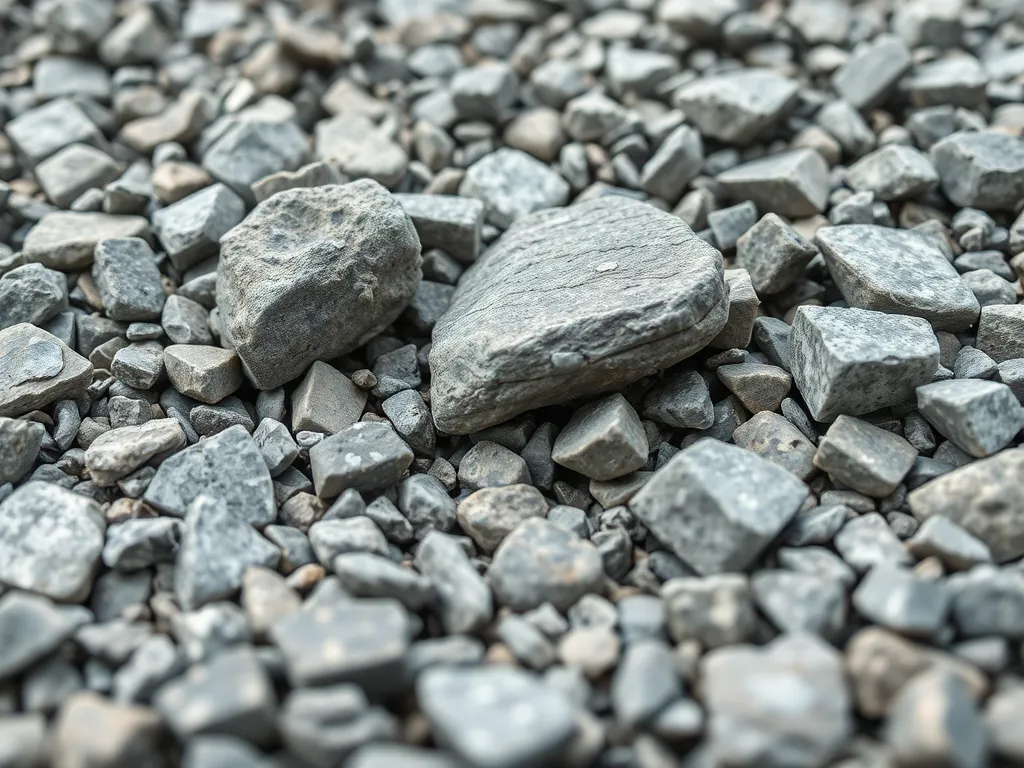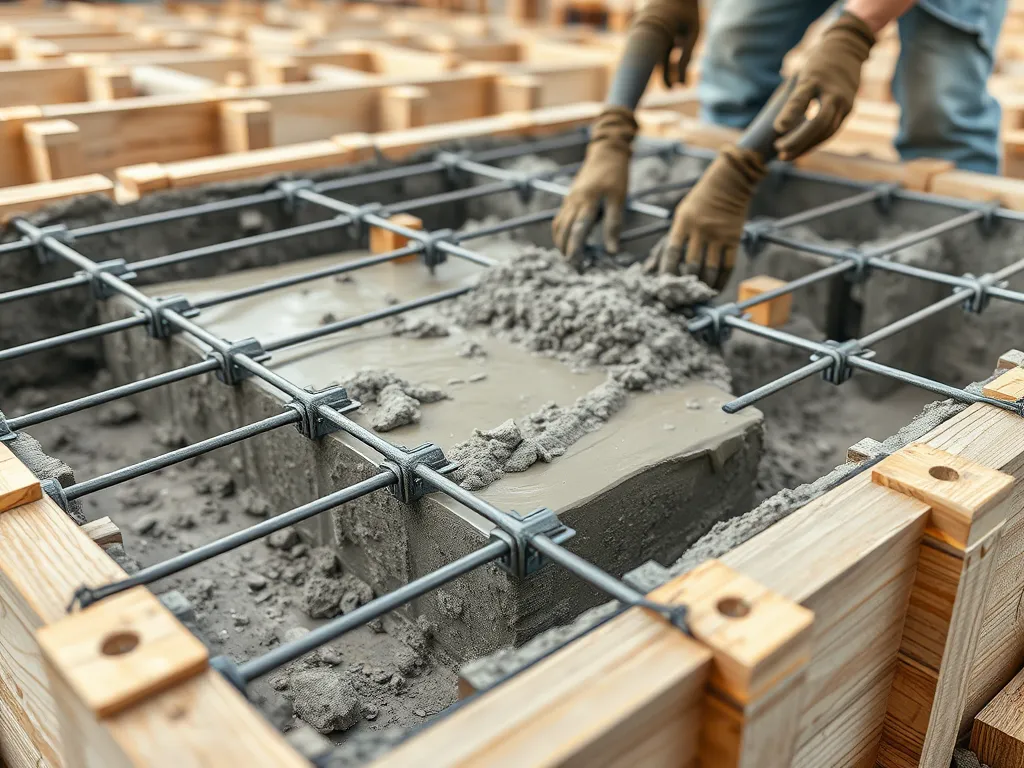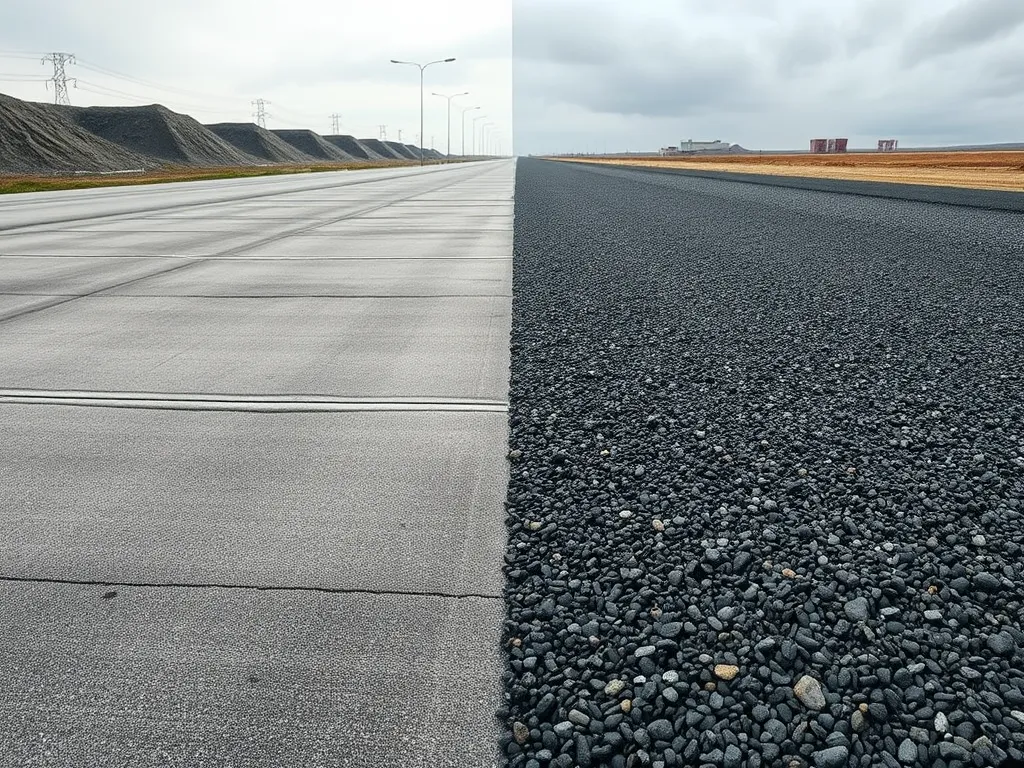Asphalt Vs Concrete Vs Gravel: Which Surface Wins for Your Project?
Published on: August 12, 2025 | Last Updated: April 14, 2025
Written By: George Voss
Asphalt, concrete, and gravel serve as top paving materials but differ in durability, cost, maintenance needs, environmental impact, and visual appeal. Asphalt (a mix of aggregates and bitumen binder) offers flexible surfaces at $3-$5 per square foot, lasting 15-20 years with sealcoating every 3-5 years. Concrete (cement, water, sand/gravel) costs $6-$10 per square foot, lasts 30+ years, but cracks in freeze-thaw cycles. Gravel (crushed stone) costs $1-$3 per square foot, requires annual replenishment, and allows natural drainage. Asphalt recycling rates hit 99%, while concrete production emits 8% of global CO2. Gravel’s rustic look suits rural areas; stamped concrete offers decorative patterns; asphalt provides a sleek black finish.
This guide breaks down critical factors for choosing between these materials. We’ll compare lifespan data, load capacities (asphalt handles 12,000+ daily vehicle counts), climate performance, and repair costs. Explore installation steps, eco-impacts, and real-world examples like a 20×20 driveway’s total price tag. Get clarity on which material best fits your budget, location, and design goals.
Contents
- Overview Of Asphalt, Concrete, and Gravel
- Key Comparisons: Asphalt Vs Concrete Vs Gravel
- Cost Analysis: Asphalt Vs Concrete Vs Gravel
- Installation and Maintenance Requirements
- Aesthetic and Functional Considerations
- Environmental Impact Comparison
- FAQs: Asphalt Vs Concrete Vs Gravel
- Closing Thoughts
- Additional Resources for You:
Overview Of Asphalt, Concrete, and Gravel
Asphalt, concrete, and gravel serve distinct roles in construction. Each material has unique properties that determine its best applications. Let’s break down their primary uses and core characteristics.
Primary Uses for Each Material
Material selection depends on project requirements like traffic volume, budget, and terrain. Here’s where each excels:
Asphalt Applications
Asphalt dominates road construction, covering 94% of U.S. paved roads. Its flexibility makes it ideal for highways, driveways, and airport runways. Contractors use hot mix asphalt (HMA) at 300°F for durable surfaces that handle heavy traffic.
Concrete Applications
Concrete’s rigidity suits heavy-load structures: bridge decks, industrial floors, and high-traffic urban roads. It’s specified for projects requiring PSI ratings above 4,000, like warehouse slabs or interstate highway sections.
Gravel Applications
Gravel provides low-cost solutions for drainage layers, rural driveways, and temporary access roads. Crushed stone aggregates (1/4” to 3” sizes) allow water infiltration at 1,000+ inches per hour, preventing pooling in flood-prone areas.
Key Material Characteristics
Performance differences stem from composition. Compare these technical specs:
Asphalt Composition and Flexibility
Asphalt combines 95% aggregates (stone, sand) with 5% bitumen binder. PG (Performance Graded) binders let it flex between -40°F and 158°F without cracking. This viscoelasticity helps it withstand freeze-thaw cycles better than rigid materials.
Concrete Strength and Rigidity
Concrete mixes blend Portland cement (10-15%), water, and aggregates. It gains strength through hydration, reaching 3,000-5,000 PSI in 28 days. Joints cut every 10-15 feet control cracking but require precise engineering.
Gravel Permeability and Versatility
Gravel’s 30-40% void space enables superior drainage. Angular stones interlock for stability, while rounded stones shift under pressure. Layer thickness matters: 4” minimum for driveways, 12”+ for truck traffic areas.
With these fundamentals established, let’s analyze how durability, costs, and climate response differ across materials.
Key Comparisons: Asphalt Vs Concrete Vs Gravel
Surface material decisions require evaluating three critical factors: structural endurance, weight tolerance, and weather resilience. Each option brings distinct advantages shaped by composition and engineering.
Durability and Lifespan
Material longevity depends on maintenance routines and environmental stressors. Performance gaps widen when comparing paved surfaces to loose aggregates.
Asphalt vs Concrete
Asphalt lasts 15-20 years with proper care, needing sealcoating every 3-5 years. Its viscoelastic binder (PG 64-22 grade common) allows slight flexing without cracking. Concrete surfaces endure 30-40 years but develop fissures from ground shifts. Rigid slabs lack flexibility, requiring costly repairs when joints fail.
Asphalt vs Gravel
Asphalt outperforms gravel 3:1 in lifespan metrics. Gravel driveways last 5-10 years before needing regrading or fresh stone. Annual erosion losses reach 15-20% in rainy climates, demanding frequent top-ups with #57 or crusher-run aggregates.
Load-bearing Capacity
Weight tolerance separates commercial-grade pavements from residential options. Load ratings determine suitability for trucks, RVs, or standard vehicles.
Asphalt Performance Under Heavy Loads
Hot-mix asphalt (HMA) withstands 18-wheelers when built with 6-8” base and 3” surface layer. Airports use polymer-modified mixes handling 150,000+ lb loads. Properly compacted asphalt deflects under weight without permanent deformation.
Concrete and Gravel Limitations
Concrete cracks under repeated heavy loads despite high PSI ratings (4,000+). Gravel shifts under tires, creating ruts and reducing traction. Loose stone compacts 20-30% during use, requiring thicker bases for temporary weight distribution.
| Material | Max Load Capacity | Key Limitation |
|---|---|---|
| Asphalt | Unlimited (with proper depth) | Softening at 140°F+ |
| Concrete | 10,000 lb axles | Joint failures |
| Gravel | 3/4-ton trucks | Lateral spreading |
Climate Adaptability
Regional weather patterns dictate material success. Thermal cycles, precipitation, and freeze-thaw actions test surface integrity.
Asphalt in Freeze-Thaw Conditions
Asphalt’s 4-6% air void content permits water expansion during freezing. Northern states use rubberized mixes that resist cracking down to -30°F. Proper crown slope (2% minimum) prevents water pooling.
Concrete Cracking Risks
Concrete expands 0.0000055 inches per °F temperature rise. Without control joints every 8-12 feet, slabs crack unpredictably. Deicing salts accelerate surface spalling, creating rough patches.
Gravel Drainage Advantages
Gravel’s 1,000+ inch/hour permeability rate outperforms asphalt (0.1-0.01 in/hr) and concrete (0.001 in/hr). Subsurface water moves freely through 3/4” angular stone, reducing frost heave risks.
Surface performance sets the stage for cost evaluations. Let’s examine pricing variables from installation to decades of upkeep.

Cost Analysis: Asphalt Vs Concrete Vs Gravel
Material costs vary widely between asphalt, concrete, and gravel. We break down pricing from initial installation to decades of maintenance.
Initial Installation Costs
Upfront expenses set the stage for long-term budgeting. Asphalt typically sits mid-range, while gravel offers entry-level pricing.
Asphalt Cost Per Square Foot
New asphalt installation runs $3-$7 per sq.ft. Regional oil prices affect liquid asphalt cement costs – PG 64-22 binder prices fluctuate between $600-$800 per ton seasonally.
Concrete vs Gravel Pricing
Concrete starts at $6-$12 per sq.ft for basic mixes. Gravel averages $1.25-$3 per sq.ft but requires geotextile fabric ($0.30-$0.75 per sq.ft) for proper base preparation.
Long-term Maintenance Expenses
Surface materials reveal true costs through years of weather exposure and use. Asphalt demands proactive care, while gravel needs constant attention.
Asphalt Sealcoating and Repairs
Sealcoat every 3-5 years ($0.14-$0.25 per sq.ft). Alligator cracking repairs cost $1.50-$3 per sq.ft. Proper drainage maintenance prevents 80% of asphalt failures.
Concrete Crack Maintenance
Concrete joints require sealing every 2-4 years ($0.75-$1.50 per linear foot). Full-depth crack repairs run $8-$12 per sq.ft. Spalling fixes add $4-$8 per sq.ft.
Gravel Replenishment Needs
Expect 30-50% gravel loss annually from erosion and compaction. Top-up costs average $0.90-$1.50 per sq.ft yearly. Geogrid reinforcement adds $0.40-$0.60 per sq.ft initially but reduces replenishment frequency.
Case Study: 20×20 Driveway Costs
A standard 400 sq.ft driveway shows clear financial differences between materials over 15 years.
Asphalt Driveway Total Estimate
- Installation: $2,800-$4,000
- Sealcoating (5x): $280-$400
- Repairs: $600-$1,200
- 15-year total: $3,680-$5,600
Concrete and Gravel Cost Comparisons
- Concrete: $4,800-$8,000 install + $1,500-$3,000 maintenance = $6,300-$11,000 total
- Gravel: $1,200-$1,500 install + $5,400-$9,000 top-ups = $6,600-$10,500 total
These cost patterns hold true for most paving projects. Next we’ll examine how installation methods impact project timelines and material performance.
Also See: Bitumen Storage and Handling Techniques
Installation and Maintenance Requirements
Surface material choices demand different labor investments and upkeep routines. Below we break down what each option requires during installation and throughout its lifespan.
Asphalt Paving Process
Hot asphalt mix arrives at 275-325°F for placement. Proper installation ensures 15-20 years of service with regular care.
Base Preparation and Compaction
Workers grade the site and add 4-8″ of crushed stone base. Steel-wheel rollers compact it to 95% density – critical for preventing cracks. Without proper compaction, asphalt develops ruts within 2-3 years.
Curing Time vs Concrete
| Material | Traffic Ready | Full Cure |
|---|---|---|
| Asphalt | 24-48 hours | 6-12 months |
| Concrete | 7 days | 28 days |
Asphalt’s faster setup minimizes project delays. Drivers can use asphalt surfaces within two days versus concrete’s week-long wait.
Gravel Installation Simplicity
Gravel requires minimal equipment: a skid-steer loader and compactor. Crews spread 2-4″ angular stones over geotextile fabric, achieving functional surfaces in hours. Annual maintenance involves regrading and adding 1″ fresh gravel to combat erosion – typically $40-$100 per truckload.
Concrete Pouring Complexity
Concrete installation needs precise execution. Workers build wooden forms, position steel rebar grids, and pour 4-6″ slabs. Power troweling creates smooth finishes, while control joints prevent random cracking. Mistakes lead to spalling (surface flaking) within 3-5 years. Properly mixed concrete uses 3,000-4,000 PSI strength ratings with 4-6% air entrainment for freeze protection.
These installation factors shape both visual appeal and daily performance – elements we’ll examine in our style and function breakdown.

Aesthetic and Functional Considerations
Surface appearance and practical performance shape decisions between asphalt, concrete, and gravel. Each material offers distinct visual styles paired with specific functional traits that affect long-term usability.
Asphalt Surface Finish Options
Standard asphalt provides a sleek blacktop surface using PG 64-22 binders for flexibility. Contractors apply sealcoating every 3-5 years to maintain dark coloration and protect against oxidation. Colored asphalt mixes incorporate iron oxide pigments or synthetic polymers for hues like red or green, though these may fade faster. Stamped asphalt overlays mimic brick or cobblestone patterns at 40-60% less cost than concrete alternatives.
Concrete Decorative Techniques
Concrete allows extensive customization through stamped patterns, acid staining, or exposed aggregates. Integral color additives blend pigments into the Portland cement mix during pouring, creating consistent tones. Broom finishes add texture for slip resistance, while polished concrete achieves glossy surfaces needing annual sealing. Decorative saw-cut joints prevent random cracking but add $2-$4 per square foot to installation costs.
Gravel Natural Appearance
Gravel’s rustic charm comes in multiple grades and mineral types – from gray crushed limestone to tan river rock. Angular crushed stone (1/4″ to 3/4″ size) stays compacted better than rounded pebbles. Loose gravel requires biannual grading to maintain even distribution and prevent ruts. Permeable surfaces reduce water runoff by 50-70% compared to paved options, blending seamlessly with rural landscapes.
Material choices impact both curb appeal and daily use. Next, examine how asphalt, concrete, and gravel perform in ecological contexts.
Environmental Impact Comparison
Surface materials directly influence ecological footprints through production methods, maintenance needs, and end-of-life disposal. Let’s break down how these options stack up.
Asphalt Recyclability
Asphalt leads construction materials in recyclability. Over 95% of reclaimed asphalt pavement (RAP) gets reused in new roads or repairs. Hot in-place recycling methods allow crews to reprocess worn surfaces without hauling material offsite. This circular approach slashes virgin aggregate use by 30-50% per project while trimming costs up to $25 per ton. Modern mixes now include 15-30% RAP without compromising structural integrity.
Concrete Production Emissions
Cement production – concrete’s key binder – generates 8% of global CO₂ emissions. Creating one ton of portland cement releases 900 kg of greenhouse gases. Though concrete lasts 25-50 years, its initial carbon footprint exceeds asphalt’s by 35-40%. Some plants now replace 20-50% of cement with fly ash or slag, cutting emissions by 400 lb per cubic yard. Still, concrete remains energy-intensive, requiring 3-7 million BTUs per ton during manufacturing.
Gravel Natural Drainage Benefits
Gravel’s 35-45% permeability rate outperforms paved surfaces. Water infiltrates at 5-10 inches per hour, reducing stormwater runoff by 60% compared to asphalt. This natural drainage prevents erosion, replenishes groundwater, and meets EPA stormwater guidelines without costly retention systems. Loose stone requires no heat processing – its carbon footprint stays 80% lower than asphalt or concrete. But frequent grading and top-ups (every 2-5 years) offset some ecological gains.
While environmental factors weigh heavily, practical budgets often drive final decisions. Up next: breaking down installation and upkeep costs across all three materials.

FAQs: Asphalt Vs Concrete Vs Gravel
Which is More Cost-effective Long-term: Asphalt or Gravel?
While gravel has a lower initial installation cost, asphalt tends to be more cost-effective long-term due to its durability and lower maintenance needs. Gravel may require frequent replenishment and maintenance, which can accumulate costs over time.
Is Asphalt Cheaper to Install Than Concrete?
Yes, asphalt is generally cheaper to install compared to concrete. The average installation cost for asphalt typically falls between $3 to $7 per square foot, while concrete installation costs range from $6 to $12 per square foot, depending on the desired finish and complexity.
What Are the Maintenance Differences Between Asphalt and Concrete Driveways?
Asphalt requires regular sealcoating every 3 to 5 years to protect against wear and oxidation, as well as occasional repairs for cracks and damage. Concrete, on the other hand, may develop cracks that need to be sealed every 2 to 4 years, and full-depth repairs can be more costly than asphalt maintenance.
How Does Gravel Compare to Asphalt for Rural Driveways?
Gravel can be a suitable option for rural driveways due to its lower initial cost and natural drainage properties. However, gravel requires more frequent maintenance, such as regrading and replenishing lost material. Asphalt offers more durability and a smoother driving surface but at a higher initial cost.
Can Asphalt Handle Heavy Vehicles Better Than Concrete?
Yes, asphalt generally handles heavy vehicles better than concrete, especially when installed with proper base preparation. Asphalt can withstand large loads without significant deformation if the thickness is appropriate, while concrete is more prone to cracking under the same stresses.
Closing Thoughts
Choosing between asphalt, concrete, and gravel ultimately depends on your specific needs and priorities. Asphalt offers an excellent balance of durability and cost-effectiveness, making it ideal for high-traffic areas. Its flexibility allows it to handle temperature shifts without cracking.
Concrete shines in durability and aesthetic appeal but comes with higher initial costs and maintenance concerns. It’s perfect for structures requiring a robust and long-lasting surface. Gravel, while versatile and economical, requires regular replenishment and may not support heavy loads as well as the other materials.
Consider factors like climate, expected traffic, and budget when making your decision. For more detailed insights and tools to assist you in calculating your specific asphalt or concrete needs, check out Asphalt Calculator USA.
Additional Resources for You:
- American Association of State Highway and Transportation Officials (AASHTO). (2008). Mechanistic-Empirical Pavement Design Guide (MEPDG). Washington, DC: AASHTO.
- Crushed Concrete vs. Crushed Asphalt: What is the Best Paving Solution?
- Gravel or concrete driveway, out in the country?? – Bogleheads.org
- Pros and Cons of Asphalt and Gravel Driveways – Today’s Homeowner
- Gravel vs. Concrete Driveway – Which is Better? – TRUEGRID Pavers


